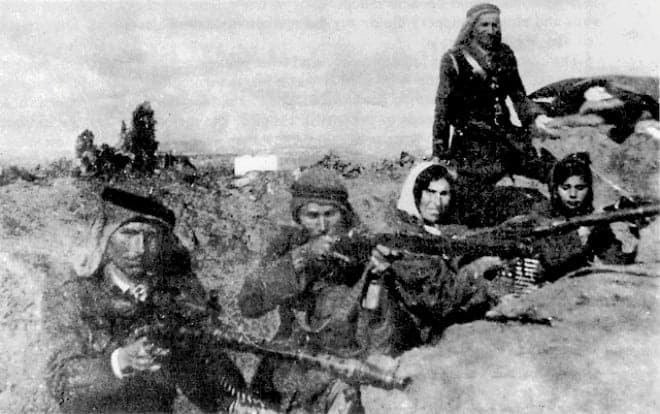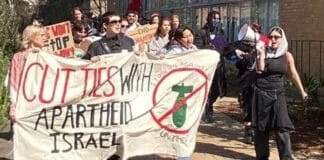Israel and Western leaders would have us believe that Palestinian resistance to Israel’s occupation began on 7 October. But the Palestinians have been fighting for liberation for generations.
In early 1936, Palestinians staged a general strike against British occupation and increasing Zionist settlement. Their action was met by vicious British military violence and armed Zionist settler gangs.
The strike lasted six months under its main slogan “Independence for Palestine”. The revolt was against British rule, British lies about the future of Palestine and involved the entire Palestinian nation.
Every village, town and city had some form of organisation supporting the strike. Arab workers went on strike. Arab shops, businesses and markets closed. Transport and communications ground to a halt.
Britain had sought Palestine as a prize after the defeat of the Ottoman Empire (modern Turkey) in the First World War.
The British takeover was part of a secret treaty signed with France in May 1916—the Sykes-Picot Agreement—to divide up Turkish possessions in the Middle East and deny access to the region to imperial rivals.
The treaty reneged on British promises to the Arab people regarding a free unified Arab nation in exchange for supporting Britain’s war against the Ottomans. This narrative was immortalised in the film Lawrence of Arabia.
Britain wanted Palestine as a base on the eastern flank of Egypt, which it dominated, and the Suez Canal—a strategic choke-point and the route to British India. The aim was to deny its rivals and to control the oil of the Middle East.
As the British navy converted to oil, Winston Churchill, First Lord of the Admiralty, said in 1913, “We must be owners, or at any rate the controllers at the source … of supply … of oil.”
Zionist settlement
Britain’s “mandate” over Palestine was ratified by the Versailles Peace Treaty in 1919, where the imperial powers carved up the world into new spheres of influence.
From then on, Britain openly encouraged Zionist settlement, which under the British government’s Balfour Declaration of 1917 was meant to lead to “the establishment in Palestine of a national home for the Jewish people”.
More and more Palestinian land was seized by Zionist settlers, bought from corrupt landlords in the towns in secret but often taken by force as Zionist gangs and militia grew in strength.
In an overwhelmingly agricultural economy, with citrus fruits, olives and olive oil being the main exports, land was central to making a living and to life.
Ten years of petitioning of the British Mandate government by the traditional leaders of Palestine led to no change in policy.
In 1933, a strike was called against the Mandate. British troops killed 33 demonstrators when they opened fire in Jaffa. More demonstrations spread in solidarity all over Palestine and then to British-controlled Iraq.
While that strike was defeated, by 1935 the economic crisis gave a sharper edge to Palestinian anger. Thousands of Arabs were turned off their land by Zionist settlers and urban unemployment grew.
There was intense pressure on the Palestinian leadership, made up of the rich land-owning families and a small, new Palestinian capitalist class, to act against British rule and Zionist settlement.
General strike
By early 1936, Britain’s refusal of demands made by united Palestinian political parties for an end to British rule saw Palestinians in Jaffa and Nablus form committees, which put out the call for a general strike.
Within three days the whole of Palestine was paralysed by the strike. The strike would last six months—the longest general strike in the history of the Middle East or Europe.
In some areas committees of nationalists took the lead. Elsewhere union branches, sports clubs, women’s committees, Muslim and Christian associations and even Boy Scouts formed the organising centres.
This expressed the strength of Palestinian national feeling but also exposed the fundamental weakness of the national movement.
From the very beginning there was no political organisation at the base which represented the interests of the mass of ordinary Palestinians.
Britain reacted with typical colonialist brutality. They made a series of mass arrests of local leaders. Its troops terrorised villages and towns throughout Palestine. Curfews were imposed and those breaking them were shot.
In Jaffa, where the strike was solid, its organising centre was inside the ancient walled city. The British army sealed off the quarter and then dynamited hundreds of homes—a tactic later borrowed by Zionists.
By June, the British High Commissioner reported to London that Palestine was in “a state of incipient revolution”. He added that British troops had “little control of lawless elements outside the principal towns, main roads and railways”.
By then more than 2500 Palestinians had been arrested and over 1000 had been killed. The Palestinians now had 5000 armed fighters in the countryside waging war on the British and the Zionist militias.
The British government increased its garrison in Palestine to 30,000 troops in a country of 1 million people. Martial law was declared. Heavy weaponry was shipped in. The RAF began strafing villages.
In addition, Zionist militias were brought into action alongside British troops. These so-called “night-squads” attacked Palestinian villages, giving the Haganah, the Zionist proto-army, its first taste of war.
It is in this context that Sir Ronald Storrs, the governor of the Mandate, wrote, “A Jewish state … could be for England ‘a little loyal Jewish Ulster’ in a sea of potentially hostile Arabism.”
Strike-breakers
The strike remained strong. But the Zionists, sensing their chance to enmesh themselves closer with the British, were happy to act as strike-breakers. They gained control of parts of the economy previously held by Palestinians. They ran transport and supplied British forces.
Palestinians were fighting both the British and Zionist settlers. That was hard enough. But there was a third obstacle in their way—the Palestinian nationalist leadership.
Within days of the general strike being called, the traditional leaders formed an Arab Higher Committee, under Hajj al-Amin al-Husayni, the country’s leading religious figure and head of the largest land-owning family.
The Higher Committee’s intention was utterly cynical—to take control of the nationalist movement and use its power to negotiate a deal with the British.
But British repression had removed many activists loyal to the Higher Committee, leaving local groups under the control of the rank and file. This led to actions initiated from below which threatened to go beyond the interests of the Higher Committee and the Palestinian ruling class.
Greater British repression led to the defeat of the largest groups of rebels. The Higher Committee realised that it was time to seek a settlement with the British and let it be known that it would accept a call from the Arab kings to end the strike.
Britain then approached King Abdullah of Trans-Jordan and his brother King Faisal of Iraq, both of whom were loyal to the British Empire, to make such a call. Despite demonstrations against the kings’ interference, the call worked.
The Palestinian leadership, drawn from the same kind of feudal strata as the kings—in particular the Mufti, the religious leader of Jerusalem—had no stomach for a full-scale national war of independence.
If they lost such a war they could end up losing all their property and the power and prestige it conferred on them.
In October, the Higher Committee called off the strike as “submissions to the wills of their majesties and highnesses”. Not for the last time would the fate of the Palestinians be decided by corrupt Arab rulers with ties to the West.
Fertile land
A new movement exploded a year later when Britain made public its plans to partition Palestine into two zones—one Zionist and one Palestinian—under British control.
The Zionist settlers, still a small minority, would receive the best and most fertile land. In response, the Palestinians—both peasants and townspeople in open revolt—waged a guerilla war that lasted another two years.
Again, massive British military brutality, including summary executions, backed by even more powerful and replenished Zionist settlers, waged war on a Palestinian resistance worn down years of fighting.
Britain offered paper concessions such as a limit on Zionist immigration and talk of “independence” after the looming world war.
The Palestinian leadership of rich landowners, large traders in the bazaar and from the mosques, were willing to sell any concession as victory.
The strike showed that imperialism would go to any lengths to deny freedom and that Palestinian workers and poor could not rely on their own ruling class to lead a fight for liberation.
Today, the working class in the Middle East is much bigger today than in 1936, especially in key countries like Egypt and Iran. If Palestinians are to win their freedom, it will be in alliance with their brothers and sisters in Cairo, Baghdad, Beirut, Amman and beyond.
By Tom Orsag






